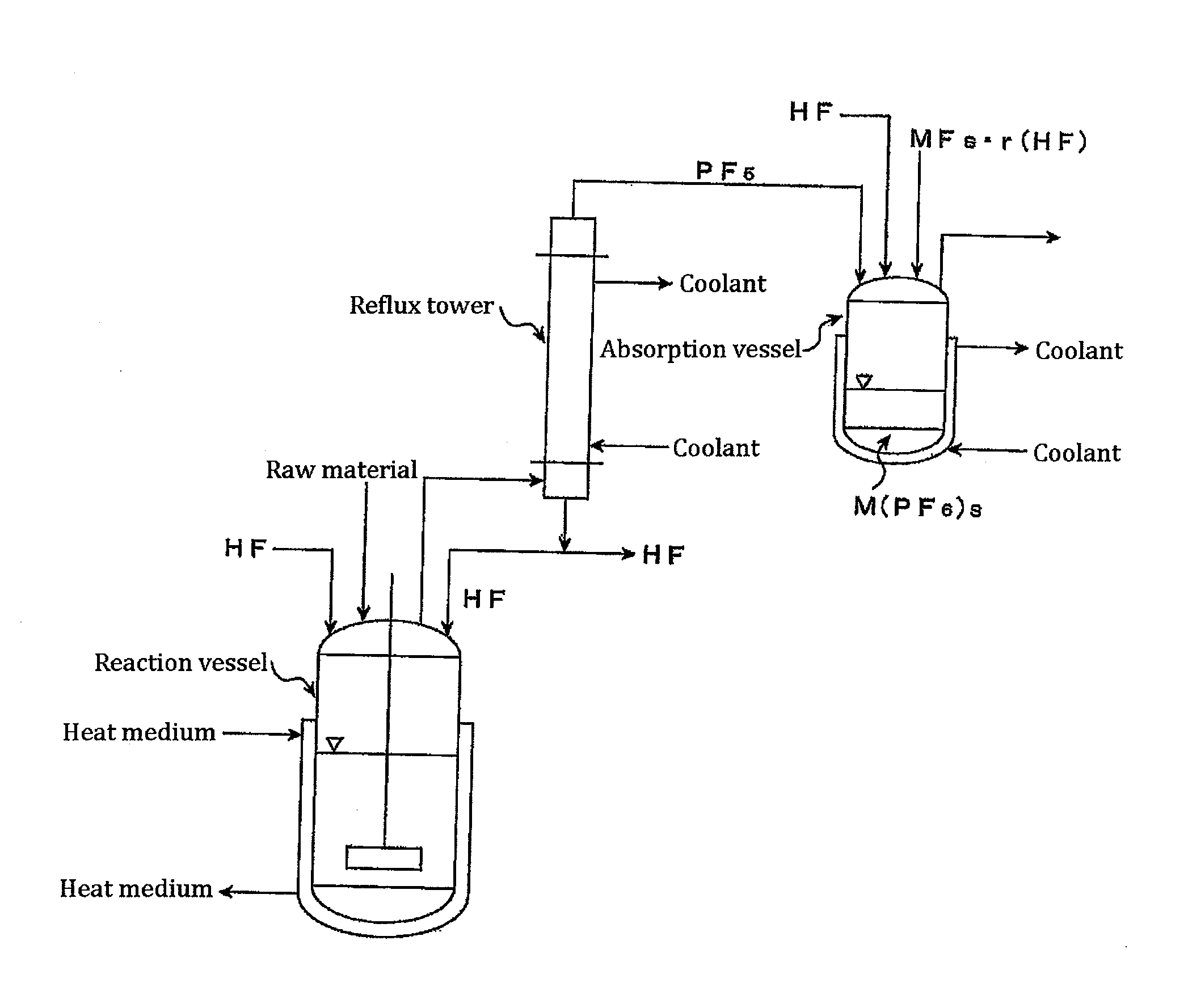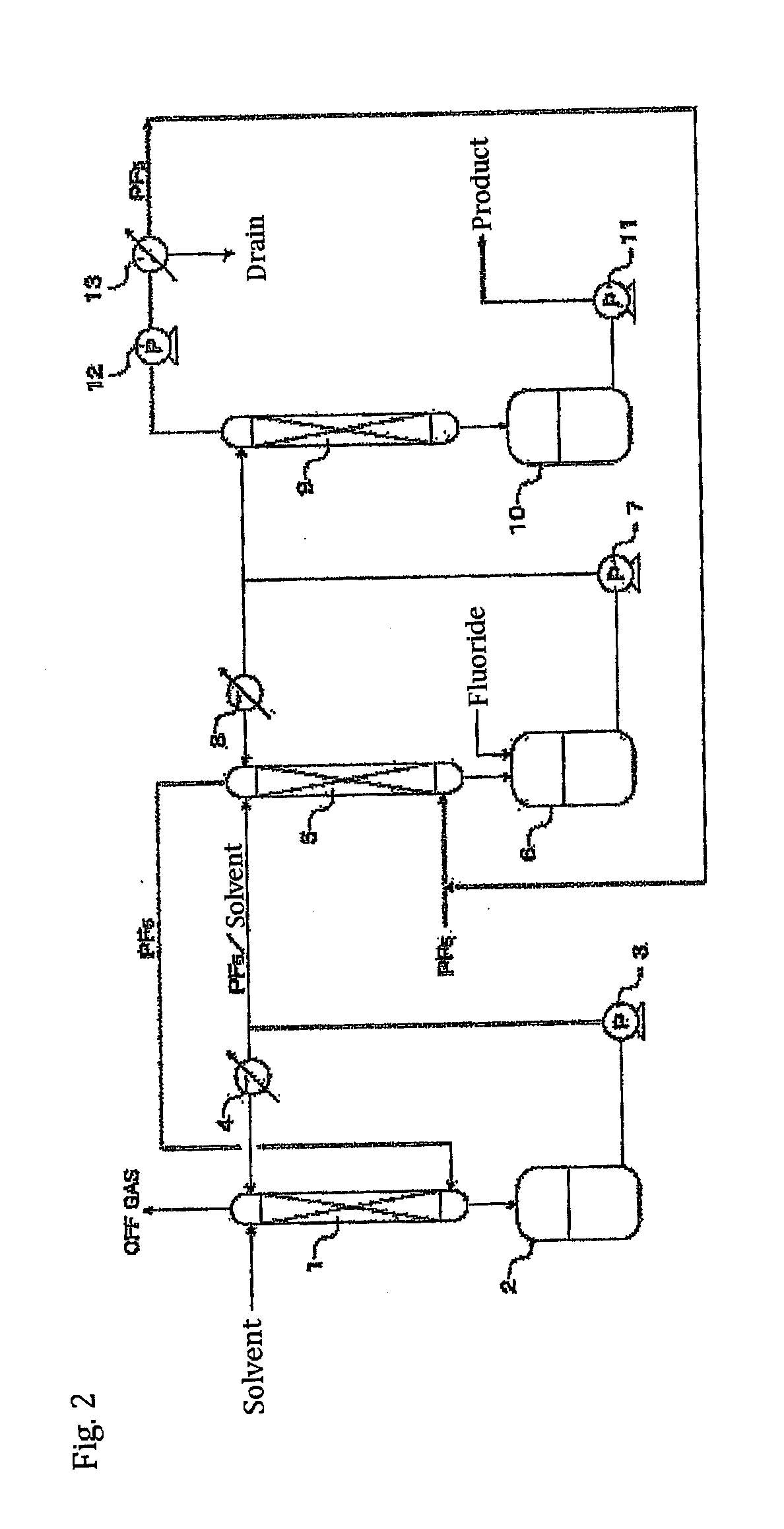Processes for production of phosphorus pentafluoride and hexafluorophosphates
a technology of phosphorus pentafluoride and hexafluorophosphate, which is applied in the direction of phosphorus halides/oxyhalides, secondary cell details, electrochemical generators, etc., can solve the problems of difficult decomposition of pfsub>5/sub>, high manufacturing cost of pfsub>5/sub>used in the manufacture of high-quality hexafluorophosphate, and high purity
- Summary
- Abstract
- Description
- Claims
- Application Information
AI Technical Summary
Benefits of technology
Problems solved by technology
Method used
Image
Examples
example 1
[0117]Using the apparatus shown in FIG. 3, the following operations were performed.
[0118]In a 5 L reaction vessel made of a fluororesin (PFA), 100 g of commercially available phosphoric anhydride (P2O5) was placed, together with a rotator, and an anhydrous hydrogen fluoride (HF) gas as a carrier gas was introduced at a rate of 10 L / min. The reaction vessel was connected to a reflux tower (20 mmφ×2 m) made of SUS316. The temperature of the PFA reaction vessel was maintained at 25° C. with a heat medium and, at the same time, the reflux tower was cooled with brine at −50° C. Furthermore, contents in the reaction vessel were stirred by a magnetic stirrer. After a period time, reflux of HF started. Thereafter, the generation of a gas from the tower top of the reflux tower was confirmed.
[0119]Five minutes after the gas was generated from the reflux tower, this gas was analyzed by a Fourier transform infrared spectrophotometer (FTIR). As a result, it was confirmed that the gas was compose...
example 2
[0120]In a 5 L reaction vessel (cooled with a coolant) made of a fluororesin (PFA), 200 g of a commercially available aqueous 75% phosphoric acid (H3PO4) solution and 2,000 g of commercially available anhydrous hydrogen fluoride (HF) were placed, together with a rotator, and a N2 gas as a carrier gas was introduced at a rate of 0.2 l / min. The reaction vessel was connected to a reflux tower (20 mmφ×2 m) made of SUS316. The temperature of the PFA reaction vessel was raised to 45° C. with a heat medium and, at the same time, the reflux tower was cooled with brine at −30° C. Furthermore, the reaction solution was stirred by a magnetic stirrer. In a few minutes, as the bath temperature increased, reflux of HF started. The temperature of the reaction solution was 23° C. Thereafter, the generation of a gas from the tower top of the reflux tower was confirmed.
[0121]Ten minutes after the generation of the gas from the reflux tower started, this gas was analyzed by a Fourier transform infrare...
example 3
[0122]In a 5 L reaction vessel made of a fluororesin (PFA), 50 g of commercially available potassium hexafluorophosphate (KPF6) and 2,000 g of anhydrous hydrogen fluoride (HF) were placed, together with a rotator, and the reaction vessel was connected to a reflux tower (20 mmφ×2 m) made of SUS316. The outside temperature of the PFA reaction vessel was raised to 45° C. with a heat medium and, at the same time, the reflux tower was cooled with brine at −50° C. Furthermore, the reaction solution was stirred by a magnetic stirrer. As the reaction vessel temperature increased, reflux of HF started. The temperature of the reaction solution inside was 21° C.
[0123]After 5 minutes, a gas was generated from the reflux tower. This gas was analyzed by FTIR. As a result, it was confirmed that the gas was composed of PF5 and a small amount of HF. After making 10 g of the generated gas to be absorbed in 0.5 kg of ultrapure water, the concentration of metal impurities in this ultrapure water was an...
PUM
| Property | Measurement | Unit |
|---|---|---|
| temperature | aaaaa | aaaaa |
| temperature | aaaaa | aaaaa |
| temperature | aaaaa | aaaaa |
Abstract
Description
Claims
Application Information
 Login to View More
Login to View More - R&D
- Intellectual Property
- Life Sciences
- Materials
- Tech Scout
- Unparalleled Data Quality
- Higher Quality Content
- 60% Fewer Hallucinations
Browse by: Latest US Patents, China's latest patents, Technical Efficacy Thesaurus, Application Domain, Technology Topic, Popular Technical Reports.
© 2025 PatSnap. All rights reserved.Legal|Privacy policy|Modern Slavery Act Transparency Statement|Sitemap|About US| Contact US: help@patsnap.com



